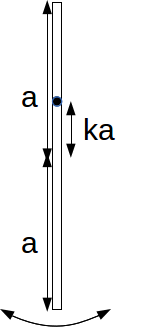If a thin rod of length a is pivoted about a point not at the centre of the rod so that it is able to move in a vertical plane, it will execute circles in a vertical plane if it is given an impulse big enough.
Suppose a rod of length![]() is pivoted about a point
is pivoted about a point![]() from the centre, where
from the centre, where![]()
The moment of inertia of the rod about the centre is![]() and the parallel axis theorem gives the moment of inertia of the rod about the pivot point as
and the parallel axis theorem gives the moment of inertia of the rod about the pivot point as![]() where
where![]() is the distance of the pivot from the centre of gravity. Hence
is the distance of the pivot from the centre of gravity. Hence![]()

If the rod is given a horizontal impulse at the bottom, the kinetic energy given by the impulse must be at least equal to the gravitational potential energy gained by the rod when it has turned through half a circle.
The kinetic energy given to the rod is![]()
The gravitational potential energy gained by the rod is![]()
The condition for vertical motion is![]()
Substitute![]() to give
to give
which simplifies to![]()
Then
